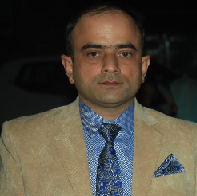Must be Prioritized to Achieve Millennium Goals and Fostering Vision India 2035
 Introduction: Architecture - a Greek word meaning master craftsman better known as mother of all arts. Architect is the nation builder, the most responsible servant of mankind. Any development that takes place must be pro-architect. An architect can totally amend the landscapes of tomorrow and henceforth bring about the change in life style e.g. Modern Housing Apartments, neighbourhoods, city life like that of modern Dubai etc.
Introduction: Architecture - a Greek word meaning master craftsman better known as mother of all arts. Architect is the nation builder, the most responsible servant of mankind. Any development that takes place must be pro-architect. An architect can totally amend the landscapes of tomorrow and henceforth bring about the change in life style e.g. Modern Housing Apartments, neighbourhoods, city life like that of modern Dubai etc.
Issues: Most of Indian cities particularly Tier-II cities like Jammu and its extension has been shaping up fast with the globally renowned Architectural lines particularly in the Commercial context. In this era of globalization and amid rapid advancing India under Prime Minister Modi, majority of the country-wide cities are in urgency of immediate legible architectural input in its new development that happens in lines with the changing scenario of transportation routes like railway and roads. The new addition of smart cities, vision towards Millennium Goals, skill India campaign and Make in India initiatives by GOI have stretched the scope of the profession in India many-fold. However, there are still many questions to be asked. Are we ready to accept these challenges? Do we have the potential and man-power to deliver such high repute projects? and many more…The answer to all these questions is obviously yes. The gap obviously lies in the initiative and glorification of the profession country-wide. The gap has resulted in the fact that most of such prestigious projects have gone to architects from abroad. Hence, the coming years may witness the infrastructure which is at par with the international infrastructure. When I say, Indian architects are not considered it means we may end up with this international infrastructure without any public realm and context. It is likelihood that the mountains of Kashmir, the hot and dry deserts of Rajasthan and coasts of Goa and Kerala would host similar sort of International Architecture. In a way, our future generations might not feel the need to visit different areas as most of the country would have become monotonous by the time we realize the importance of Indian diversity and celebration of this diversity by the locals including the local Architects. Our historical diverse sense rooted in cultural values to compliment the landscapes with (clothing’s and) architecture speaks volume of the wisdom and sense to celebrate the overall God’s creation even with the addition of man-made structures. After all, it’s the buildings only which strikes the human memory as landmarks or image makers of the city, town or locality. At the end of the day, stage may be avoided else architects would have to listen to many decision-makers who would vow for projects without even architects. Instead, they would advocate the use of computer simulations and internet to create similar projects all over the globe no matter the location or the country and even the funds. The imageability, adaptability, vulnerability and the spatial organizations would not even cross the jury rooms of architecture education.
Infrastructure can be created and normally government is at the helm of affairs to create it with the support of some engineers, bureaucrats and most of the time even without consulting architects. Indeed, the infrastructure is placed in the space judiciously only be one professional in this world i.e. an architect. Like architects are neglected in the prestigious projects, it promotes that the architecture career is also neglected relatively amongst youth from even the leading cities of the country. Prime reason is the availability of less architects in the country as compare to the engineers. Further, the availability of lesser architectural education institutions in the country is directly the breeding factor for that.
In the state of Jammu and Kashmir, there is only one architectural education department i.e. department of Architecture and Landscape Design, Shri Mata Vaishno Devi University imparting UG (B.Arch.) 5-year course in Architecture. Though diploma course (2-3 years) is available in some of the polytechnics of the State. The other conclusion of neglecting architecture as career option is the improper knowledge regarding the pros and cons of the said course. Architecture need to be honoured and understood first particularly viz-a-viz like its counter-part career options. Architecture and Architects must be promoted and must lead the initiatives in the fast-developing country - India, like never before, if the country want to realize the dreams like sustainable development goals, India 2035 and Millennium goals etc due for next 8-10 years.
Explication: Presently, Bachelor course in Architecture is available in many varied sub-fields of Architecture like Landscape, Interior Design, Digital Design, Planning & Urban Design etc. However, a general B.Arch. Course is the mostly pursued as the most applicable one. B. Architecture is divided into 5-years i.e. 10 semesters. Student learns various basic aspects of designing, history of Architectural world (advancement in built form encompassing different civilizations), building services (fixtures, water supply & drainage) & structural aspects of a building in first 06 semesters with the help of Lectures followed by design studio work. This is accompanied with site visits, study tours for practical exposure. In the summer vacations, students engage themselves in some practicing Architect’s office in their home town to have field experience and to implement class learning. Students do the mandatory internship in India or Abroad for six months under some Architect or Architectural organization normally after 6th semester to have the total exposure of the practical field. After -wards, jury is conducted to review the work done by the student in the internship with the help of external experts (eminent professionals from the field). 8th & 9th semester is meant to conduct high level learning in terms of building design (campuses, apartments, hospitals) advanced building construction and advance structures. Ultimately, Student do the requisite B. Arch. major thesis project in 10th semester under a supervisor amongst the faculty members chosen systematically for the purpose. In this project, a live or design project of pre-requisite scale is taken up by the student and an comprehensive design proposal along with the project report consisting of project details, prototype studies, site details, requirements and design criterion/concept is required to be prepared & submitted by the student under the supervision of respective Guide in the course of the semester. Overall work is evaluated by jury members comprising of internal faculty & external examiners (academicians/practicing Architects) in 4-5 stages during the semester. This is the most critical component of the degree course as such this prove to be the vital part for the student to earn their job particularly to start with.
Students from countrywide Architectural colleges interact among themselves twice a year on Zonal & National basis under Zo-Nasa & Annual Nasa convention respectively (National association of students of Architecture). After the successful completion of B.Arch. course, student becomes eligible for the award of B.Arch. degree & henceforth for the practicing licence from the Council of Architecture (COA).
Well, it is established now that an Architect (Ar.) is a licensed professional at par with the Doctors (Dr.) and Chartered Accountants (CA) for further growth in professional or academic field. B.Arch. is a comprehensive 5 year programme and along with it, architect’s professional practice is governed by the Council of Architecture, New Delhi, set up by the GOI under Architects Act, 1972. After B. Arch, one may opt for higher studies for specializations like M. Arch. (general), M. Arch. (Landscape Design), MURP (Masters in Urban & Rural Planning), M. Planning, M. Arch. (Urban Design) and Masters in Interior Design. Common route to pursue such courses is through GATE exams as such all these courses are available in leading institutes of the country like IIT’s & SPA’s etc. Student of Architecture after B.Arch. may also proceed towards product designing (M. Des.) through exam like CEED as such institutes like NID-Ahmadabad, IIT Bombay & IIT-Delhi are the preferred destinations for the same. Many students of Architecture from SMVD University, Katra also pursue Masters from leading institutes of USA, Canada, Europe, UK and other parts of the world through GRE and other exams.
Prospects: Candidate becomes eligible for personal practice straight after B.Arch. unlike any other graduate counterpart as soon as he/she gets the Licence from the Council of Architecture (COA). Normally, one prefers to work under some architect of repute in some leading town of the country like metropolitan cities for 2-3 years & then ultimately establishes own private practice majorly in the home town. Though it may prove to be an exercise of patience to start with but for a seasoned Architect sky is the limit in private practice in name, fame & financial aspects in today’s ultra-modern world.
Moreover, those having the rare teaching inclination one may opt for teaching as full time, part time or visiting straight after B. Arch. (First class) as applicable under COA guidelines. However, currently it is recommended to start the teaching career after specialization (Masters). Besides teaching, one may continue to increase the personal qualification in terms of Masters and Doctorate through different avenues. Simultaneously, one may continue to practice under institutional consultancy which has added benefits at promotion avenues while in teaching; besides the financial benefits & experience of large scale projects. Various Govt. Departments, establishments and organizations like PWD, MES, L&T, DLF demand Architects for various prestigious posts as high as Chief Architect of the State.
Though most of the engineering branches are viewed under one lens off late and architecture is increasingly attempted to be merged with these branches. Indeed, it’s a unique 5-year comprehensive professional course with its very different teaching –learning environment. Department of Architecture, SMVD University, Katra is the only available destination in the State currently. It’s a high-time to pursue a career in architecture as built form is always bound to take place as long as there is human on the planet. Pertinently, majority of the state is in urgency of immediate and concerned architectural input in new development that happens in lines with the changing scenario of transportation routes in addition to the initiatives required towards Smart City Mission.
Architecture with its job creating characteristics unlike job seeking ones is the need of the hour in presently unreliable market scenario e.g. Civil Engineers (Structural Engineers), Surveyors, Valuers and besides other varied type of engineers/consultants applicable for special type of buildings are commonly employed by the architect as the Architect is the boss of the operational team for any specialized building to be designed & built. So, pursue a career in Architecture, be a part of this unique Architects' fraternity, gets involved with the mood and chant of the spaces, shaping up of spaces into the places and glorify your motherland Jammu & Kashmir as it badly needs your strategic efforts as an Architect and Planner in coming years. Undeniably, being the aura of an architect of the built form, interior spaces and places is something very special and sensitive like its building solutions ought to be.

 SMVDU Alumnus Secures Seat at Rhode Island School of Design...
SMVDU Alumnus Secures Seat at Rhode Island School of Design... Ar. Abhiney Gupta Bags Certificate of Merit at Indian Institute of Architects (IIA) Convention...
Ar. Abhiney Gupta Bags Certificate of Merit at Indian Institute of Architects (IIA) Convention... SMVDU Faculty tops with Gold Medal+Elite certification in NPTEL Course...
SMVDU Faculty tops with Gold Medal+Elite certification in NPTEL Course... SMVD University Student Scores to Harvard Graduate School of Design...
SMVD University Student Scores to Harvard Graduate School of Design... Ar. Aditya Kumar singh Delivers Talk at International Conference, LPU...
Ar. Aditya Kumar singh Delivers Talk at International Conference, LPU... Ar. Aditya Kumar singh Bags National Architecture & Interior Design Excellence Award...
Ar. Aditya Kumar singh Bags National Architecture & Interior Design Excellence Award... Prof. Garg, Faculty SMVDU, authors “Science Beyond Quantum”...
Prof. Garg, Faculty SMVDU, authors “Science Beyond Quantum”... Ar. Aditya kumar singh delivers Online Lecture at OCULUS India...
Ar. Aditya kumar singh delivers Online Lecture at OCULUS India... Ar. Sourovee Dutta Presents Research Paper at Thailand International meet...
Ar. Sourovee Dutta Presents Research Paper at Thailand International meet... Ar. Abhiney Gupta Presents Research paper in Spain...
Ar. Abhiney Gupta Presents Research paper in Spain... Ar. Abhimanyu Sharma presents paper at Barcelona, Spain...
Ar. Abhimanyu Sharma presents paper at Barcelona, Spain...
